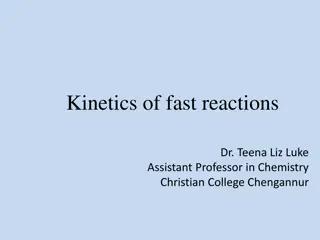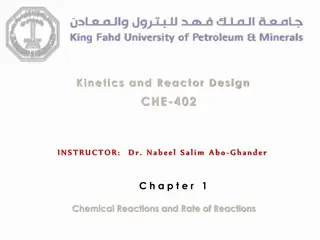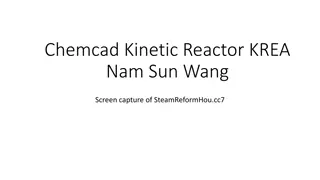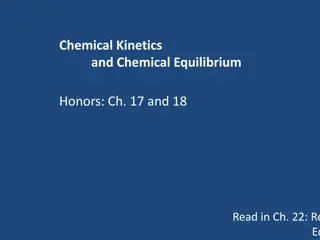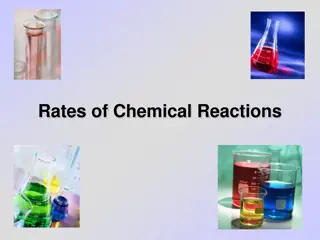Understanding Chemical Reaction Kinetics: From Unimolecular to Three-Body Reactions
Explore the fundamental concepts of chemical reactions, including unimolecular reactions like thermolysis and photolysis, bimolecular reactions, and three-body reactions. Learn about rate constants, reaction mechanisms, and the impact of pressure on reaction rates. Discover how energy transfer, photon absorption, and quantum yields play crucial roles in different types of reactions.
Download Presentation

Please find below an Image/Link to download the presentation.
The content on the website is provided AS IS for your information and personal use only. It may not be sold, licensed, or shared on other websites without obtaining consent from the author. Download presentation by click this link. If you encounter any issues during the download, it is possible that the publisher has removed the file from their server.
E N D
Presentation Transcript
Introduction: basic chemical concepts Basic reading: chapter 9 of Jacob (1999) Advanced reading: chapter 5.3 of Brasseur and Jacob (2017)
Unimolecular reaction: thermolysis inert molecule denoted M (such as N2, O2) transfers energy by collision A + M B + C + M excited form of A (rate constant k) Overall reaction: A + M A* + M (rate constants k1, k-1) Mechanism: A* B + C (rate constant k2) Assume quasi steady state for A*: production = loss [A][M] k = Reaction rate: [A] [B] [C] d d d k dt dt dt [A][M] [M] k + = [A*][M] [A*] [A*] k k 1 1 1 2 + k k 1 2 [A][M] [M] 2 1 k k k 1 2 k k = = = = = = [A*] [A][M] with k k 2 + + [M] k k k 1 2 1 2 k Low-pressure limit: k k = k k = k 1 2 1[M] k High-pressure limit: 1 rate(2) >> rate(-1) [M] k rate(2) << rate(-1) B + C -d[A]/dt = k[A] = M / 1 2 k k k A In high-pressure limit, write instead 1
Unimolecular reaction: photolysis [A] dt d + = A B + C [A] h k k [s-1] is the photolysis rate constant (also called photolysis frequency) wavelength [cm] Solar radiation actinic flux distribution function [photons cm-3 s-1] = ( ) ( ) k q d X X 0 actinic flux [photons cm-2 s-1] absorption cross-section [cm2 molecule-1] quantum yield: probability that photon absorption causes photolysis Absorption cross-section photon is not absorbed photon is absorbed Probability of absorption for incoming photons = /A Molecular cross-section A
Example of photolysis reaction: O3 + hv O2 + O(1D) = ( ) ( ) k q d X X 0 actinic flux at sea level ozone absorption cross-section q Photolysis at sea level is controlled by photons in 300-320 nm range O(1D) quantum yield q
Bimolecular reaction A + B C + D [A] dt d = = [A][B] k ( ) k T exp[ / ] A E RT Rate: a Arrhenius expression Ea Reaction is exothermic if heat is released: likely to occur, but may be slow if Eais large Reaction is endothermic if heat is absorbed: unlikely to occur at significant rate
Three-body reaction Overall reaction: A + B + M AB + M A + B AB* ( ) k k Mechanism: 1, 1 + AB* + M M* AB + M* ( ) heat k 2 M [A][B][M] [M] k + [AB] dt 1 2 k k k d = From steady state for AB*, general solution: ? 1 2 ko [AB] dt 1 3 k k k d = = [A][B][M] [A][B][M] k Low-pressure limit: o 2 [AB] dt d = = [A][B] k [A][B] k k High-pressure limit: 1 [ ] k M [AB] dt d = o k M k F = [A][B] k with General formulation: [ k ] + 1 o F is a correction factor for the transition regime
Atmospheric lifetime and first-order loss concentration loss rate = Define atmospheric lifetime as Loss rate L can be from chemistry, deposition, transport Concentration can be equivalently expressed as mass with L in appropriate units = = [A] 1/ L k k Loss rate is often proportional to concentration (first-order): effective loss rate constant In absence of source, first-order loss leads to exponential decay with time scale : [A] [A] d dt Atmospheric lifetime tells you: 1. How far a chemical can be transported away from its source; 2. How rapidly it responds to changes in its sources/sinks; 3. How rapidly it reaches steady state between sources and sinks (same as 2, but worth stating) = [A] [A](0)exp[ = [A] ] k kt [A](0) [A](0)/e 0.37[A](0) = 1/k t
Equilibrium constants If we have a forward reaction A + B C + D (rate constant kf) then we must have the backward reaction C + D A + B (rate constant kb) If the backward reaction is negligible then the forward reaction is said irreversible If the backward reaction is significant then the forward reaction is said reversible. If the backward reaction is fast then the species may be in equilibrium: k k [ ] d A dt C D [ ][ ] [ ][ ] A B = = = = [ ][ ] k C D [ ][ ] k A B K equilibrium constant f 0 A + B C + D b f b Ionic dissociation reactions in water are fast and best described by equilibrium constants: A+ + B- AB + =A B [ ][ ] K A+ + B- AB AB [ ] water molecules: solvent cage
Optical depth and Beers law scattering or absorbing medium transmitted radiation flux incident radiation flux F(x) F(0) F(L) x L 0 = Beer s law: dF kFdx where k [m-1] is a scattering+absorption coefficient L = = ( ) k x dx Integrate: ( ) (0)exp[ ] F L F where is the optical depth 0 Application to atmospheric aerosol: F( ) Aerosol optical depth (AOD) a.k.a. aerosol optical thickness (AOT): AOD ln[ ( )/ F = Aerosol scattering and absorption (0)] F F(0) Earth surface









